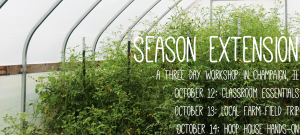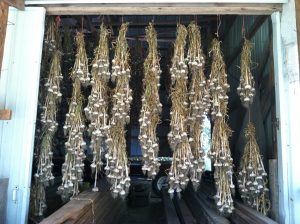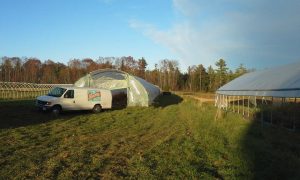 Although I’m not currently farming, I love reading industry rags. So when Vegetable Growers News showed up at our office recently, I was excited. Headlines like “Higher potato consumption goal of social media effort” and “Federal grant awarded for organic tomato research” are sure to catch my eye, but this time I was looking for mentions of a certain phrase. I was not disappointed.
Although I’m not currently farming, I love reading industry rags. So when Vegetable Growers News showed up at our office recently, I was excited. Headlines like “Higher potato consumption goal of social media effort” and “Federal grant awarded for organic tomato research” are sure to catch my eye, but this time I was looking for mentions of a certain phrase. I was not disappointed.
One headline read “Hoop houses make winter most profitable season” and another touted the use of cover and cool-season crops to bolster yields in organic fields. Still another discussed recent technological advances to reduce winter storage losses by 50%. All of these were touting the benefits and technical details of producing and selling out of the normal bounds of the growing season. In other words, season extension is hot.
Usually when the topic comes up, conversation strays to high tunnels and greenhouses. While these are some of the most commonly used tools for growing in the “shoulder season”, they do not nearly capture the breadth of season extension. It is actually a broad set of practices, underpinned by some simple principles. These principles include solar capture, timing, and crop choice.
 From these basics, a farmer can build a season extension strategy. Sometimes this is as simple as identifying natural microclimates on one’s farm and using them to grow longer season crops or those that like high heat. As we begin to add more inputs of time and capital, the practices that farmers use can range anywhere from low tunnels to storage crops to heated greenhouses and value addition. And no season extension strategy is complete without careful attention to marketing, record-keeping, and labor management.For all of this effort, the payoff is greater than simply having more product to sell. Off-season margins are higher on average, income year-round means a steadier cash flow, and brand loyalty is developed when customers can turn to your business for product even in the cold months. In addition, investment in infrastructure can strengthen your business, create equity, and help manage risk.
From these basics, a farmer can build a season extension strategy. Sometimes this is as simple as identifying natural microclimates on one’s farm and using them to grow longer season crops or those that like high heat. As we begin to add more inputs of time and capital, the practices that farmers use can range anywhere from low tunnels to storage crops to heated greenhouses and value addition. And no season extension strategy is complete without careful attention to marketing, record-keeping, and labor management.For all of this effort, the payoff is greater than simply having more product to sell. Off-season margins are higher on average, income year-round means a steadier cash flow, and brand loyalty is developed when customers can turn to your business for product even in the cold months. In addition, investment in infrastructure can strengthen your business, create equity, and help manage risk.
One major benefit that can go unrecognized is how season extension can affect your workforce. A talented group of workers can be difficult to retain when there are 4-6 months out of the year when you have no paid work to offer them. With a season extension strategy, farm business owners can offer their workers more permanent employment and cut down on the annual scramble to find personnel. (For more useful information on farm labor management, check out our upcoming workshop.)
Our job at The Land Connection is to identify opportunities for farmers and create valuable training that helps them embrace those opportunities. That’s why we are offering a three-day workshop on season extension from March 2-4 in Champaign, IL. Participants will hear presentations from experienced farmers and other experts on the subject, go on tours of farms and a value-added food processing facility, and interact hands-on with a production high tunnel and its crops. When folks leave this workshop, they will be ready to go home and begin planning a season extension strategy for their farm business. They will even receive the first copies of a Season Extension Guide that we are developing, containing practical, approachable information on the subject, including case studies of farms that have successfully integrated these practices.
Have you ever heard your customers lamenting the lack of fresh food in their diets once the snow flies? Tired of trying to make the books work in the long winter months? Extending your production and marketing all the year round may be the right way forward for you. Come learn how with us!



